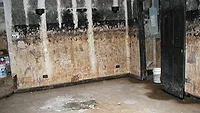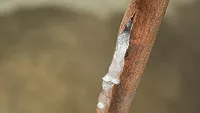How to Restore Property Damage from an Ice Dam
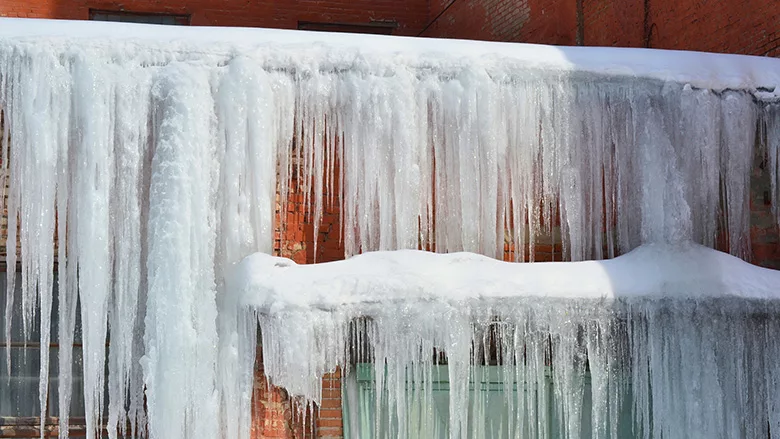
Photo credit: LegART / iStock / Getty Images Plus via Getty Images
As we approach the cooler change of seasons, we look forward to many things; the stunning change of foliage, football, and atmospheric water vapor frozen into ice crystals and falling in light white flakes, more commonly known as snow.
If you live in the north, you’ve probably had anywhere from a few inches to several feet of snow at one time or another. Regardless of your location, if you have experienced snow accumulation along with freezing temperatures and certain building conditions, you may have been the recipient of an ice dam.
The term “ice dam” refers to the damming of water behind an accumulation of ice buildup along the eaves and/or valleys on a roof covered with snow. Heat loss from the home or building into the attic space or rafter cavities warms the roof deck and causes snow to melt. When this snowmelt reaches the eaves, it freezes as there is no heat loss in this area. This can lead to a buildup of ice and a backup of water, hence the term “ice dam”. See Figure 1 and 2 below for additional details.
This paper reviews the causes of ice dams and discusses mitigation of damage when an ice dam forms. We will also review ANSI/IICRC standards to determine the categorization of water from ice dams.
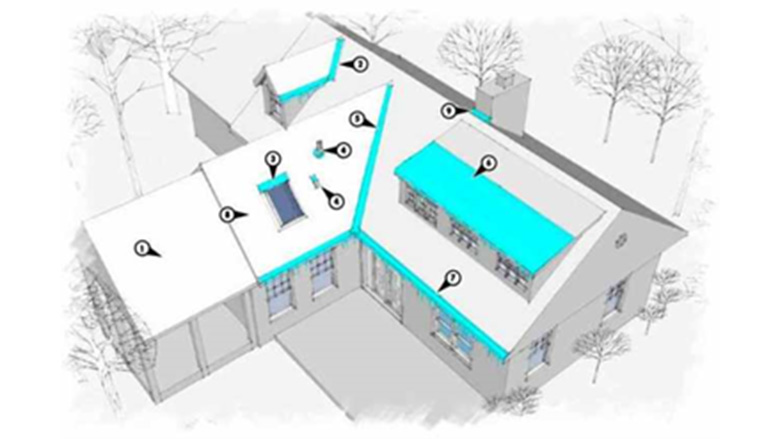
Ice Dam Basics
There are a few key points that differentiate an ice dam condition from typical snow accumulation on a roof:
- The outside temperatures must be below freezing for a duration long enough to allow freezing at the roof edge to occur. An ice dam will not typically occur during an early winter snow when outdoor temperatures are just beginning to decline, or they routinely move above and below freezing during the day.
- A large enough snowpack (mass of snow that is compressed and hardened by its own weight) must exist on the roof. If the snowpack on the roof is not substantial enough, as it melts, there may not be enough water to form the dam or become deep enough behind the dam to flow back into the building structure. Moisture can only enter by two means. One is s hole, crack, etc. The second is if moisture is moving through a material already within the loss structure or area. Typically, ice dams get in between the roofing materials and will enter between two joining ends of the oriented strand board (OSB) tongue and groove and/or opening, or by absorption into the OSB. In other words, the dam “flows back into the building structure.”
- A heat source must exist that warms the roof sheathing and melts the snowpack. This heat source is typically from the interior of the structure but can also be the result of solar radiation heating the snowpack. Ice dams can occur above the soffit ventilation as the cold/freezing wind forces its way into the attic space, cooling the back of the interior OSB.
Soffit Ventilation
Ice dams are not as likely in early winter due to weather conditions that typically contain lower snowfall amounts and temperatures fluctuating between 20 and 30 degrees. In contrast, later winter months are more conducive for the conditions that result in an ice dam. One example occurred in February of 2010, when Pittsburgh, Pennsylvania received upwards of 24 inches of snow during a three-day period. The temperatures during that snow, and for two weeks afterward, stayed in the low 20’s to teens (can we just say below freezing?). As a result, numerous structures throughout the greater Pittsburgh area experienced ice dam issues.
Of course, geographically, weather conditions vary greatly and as a result the frequency and magnitude of ice dams will vary as well.
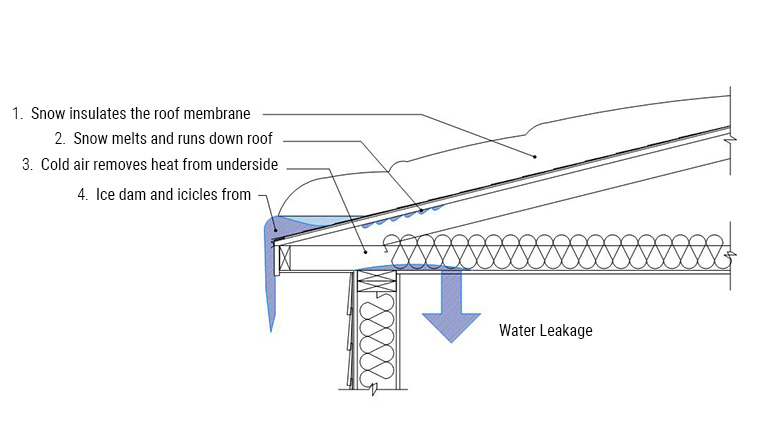
Mitigation
When water is entering through a ceiling of a residence (possibly from an ice dam), clients commonly ask about how to mitigate the resulting damage from an ice dam condition. Typically, snow will not “pour” into a building; rather, it will become absorbed or will collapse the roof with its weight. The solution to this problem is actually very simple — remove the water source. However, the execution of the solution can present some challenges and safety concerns during removal.
While easy in theory, the removal of snow from a steep, icy, and snow-covered roof is dangerous work.
Removal of the water source — the snow — will eliminate the potential for the ice dam to grow and it will also eliminate the potential for water to back up under the roofing material and ultimately enter the structure. While easy in theory, the removal of snow from a steep, icy, and snow-covered roof is dangerous work.
Professionals who are familiar with working in these conditions should be engaged. In addition to the dangerous conditions mentioned above, the weight of several feet of snow, combined with shovel-wielding workers bouncing on a roof, could lead to a sudden roof collapse.
If the snow cannot be removed, what should be done? Let’s first discuss what not to do.
- Do not remove the gutters. While removing the gutters may eliminate some of the ice dam, it typically removes only the bottom portion of the dam. The upper portion at the eave still exits. Plus, it is dangerous to attempt to remove a frozen chunk of gutter that is several feet in the air.
- Do not break the ice dam up with an ax, hammer, or other tools of destruction. Hitting ice adhered to frozen, brittle shingles or in a gutter is a sure way to damage the existing structure materials. Common damage incurred includes cuts, punctures, and displacement of the material. When the ice begins to melt, water may pour into the structure through the holes created by the physical removal of the ice dam.
- Do not apply salt or calcium chloride to the ice dam. This may work in theory, but likely will not work if the snowpack still exists above the melted remnants of the ice dam and the exterior conditions stay the same. Additionally, placing these products on roofing materials can cause immediate and/or long-term damage to the existing structure materials.
- Do not open up the ceiling where the water is leaking into the structure. Building owners and contractors alike tend to do this. The rationale is that because the ceiling and insulation is wet, mold will grow. Earlier in this paper, the warming of the roof deck from rising heat was discussed as a contributing factor to ice dams. Opening a ceiling, removing the insulation, and allowing large amounts of warm air to impact the roof sheeting will not help the situation at hand. Opening the ceiling after the ice dam event is over, for the year, would be a plausible solution.
Water Categorization
Although not specifically defined in the current edition of the ANSI/IICRC S500, Standard and Reference Guide for Professional Water Damage Restoration, (S500), water from an ice dam that enters a structure could be placed into either of the three categories depending on the situation.
The categories of water, as defined by the current S500 document in Section 10.4.1, refer to the:
- Range of contamination in water
- The water’s origin/source and its quality after it contacts materials present on the job site. We can know and consider snow as “clean” water, as its source is the sky, but this water has come into contact with other snow, ice buildup, roofing tiles, and the roofing moisture barrier. The ice dam produces moisture between the barrier, or through the install holes (nails, staples) that allow the moisture to migrate between various openings (cracks, nail holes, wood knots, etc).
- Time and temperature, which can increase/decrease the amplification of contaminants, thereby affecting the water’s category. This is where there is potential concern, as processes described above can lead to microbial growth and contamination of the moisture/water.
Restorers should consider the possibility that contamination has occurred. Contamination in this case is defined as the presence of undesired substances — the identity, location, and quantity of which are not reflective of a normal indoor environment — which can produce adverse health effects, cause damage to structures, systems, or contents, and/or adversely affect the operation or function of building systems.
Some say these categories are for human or animal (living) safety and health; however, they are in fact reflective of the build itself, its materials, assemblies, contents, and any products.
Category 1 Water
The S500 defines melting ice and snow as part of category 1. In theory, if the water does not contain any contaminants or additives that may be picked up while melting and/or being absorbed by building materials, then it could be classified as Category 1. These conditions would most likely not occur with an ice damming condition.
It is important to note that, if, for instance, a building’s supply line ruptures (which is Category 1) and the event affects asbestos materials that have to be removed, the situation is still considered a Category 1 with the presence of a regulated material.
Category 2 Water
The S500 does not discuss melting ice and snow in category 2. It states that category 2 “contains significant contamination and has the potential to cause discomfort or sickness if contacted or consumed by humans.” Because of the potential to contain contamination as the result of flowing through building materials, category 2 appears to be the best definition of water that enters a structure from an ice dam and does not contain a significant hazard.
To elaborate, snow and ice melt will move through the OSB pores where there exists wood and glue (glue is not porous). It then weeps onto the insulation, where it is absorbed, and often will stay in place due to felt paper (with alumina backing), preventing any further movement. If there is long term exposure to the intruding water, the insulation would eventually lose its ability to adsorb more water and allow for the moisture to flow to the drywall ceiling below. Drywall would then adsorb or absorb the moisture (it is porous); the water would then stay as the paper layer prevents it from moving further or allows it to become a stain. With enough weight accumulated, this water could cause the drywall ceiling to fail or collapse. Again, the water itself is not presenting the danger; rather, it is the structural materials. Therefore, intruding water should not be touched or ingested, and using PPE is recommended when handling these situations.
Category 3 Water
The S500 again does not discuss melting ice and snow in category 3. By definition, Category 3 water “is grossly contaminated and can contain pathogenic, toxigenic, or other harmful agents (fungi, bacteria, etc.) and can cause significant adverse reactions to humans if contacted or consumed.” It is important to note that this category only applies to the degree of biological contamination. In the definition of categories, the presence of regulated materials such as asbestos, lead, and even mold fall under a specific paragraph in the S500 that addresses those specific materials because they may require a specialized expert to test, remove, or sample.
Ice dams are a common issue for roofs in northern climates—most often occurring on eaves, though capable of occurring elsewhere—and they will continue to pose a challenge in terms of how to best manage the conditions that cause ice damming and/or fix the resulting damage.
Good building design, maintenance, and code compliance are good practices for ice dam prevention; however, since the weather plays a crucial role in the frequency and severity of ice dams, building owners may not always have the final say when dealing with an ice dam condition.
Acknowledgments
We would like to thank John DiMenno, CR, CMRS, CMP and Josh Woolen for providing insight and expertise that greatly assisted this research.
References:
- American National Standards Institute/Institute of Inspection Cleaning and Restoration Certification. ANSI/IICRC S500-2015 Standard and Reference Guide for Professional Water Damage Restoration, Fifth Edition. Las Vegas: IICRC, 2021.
- Lstiburek, Joseph. “Dam Ice Dam.” Building Science Corporation BSI-046 (2011) : 1-16
- Lstiburek, Joseph., and John Carmody. Moisture Control Handbook: Principles and Practices for Residential and Small Commercial Buildings. New York: Wiley & Sons, 1994
- Straub, John. “Ice Dams.” Building Science Corporation BSD-135 (2006) : 1-17
Looking for a reprint of this article?
From high-res PDFs to custom plaques, order your copy today!





